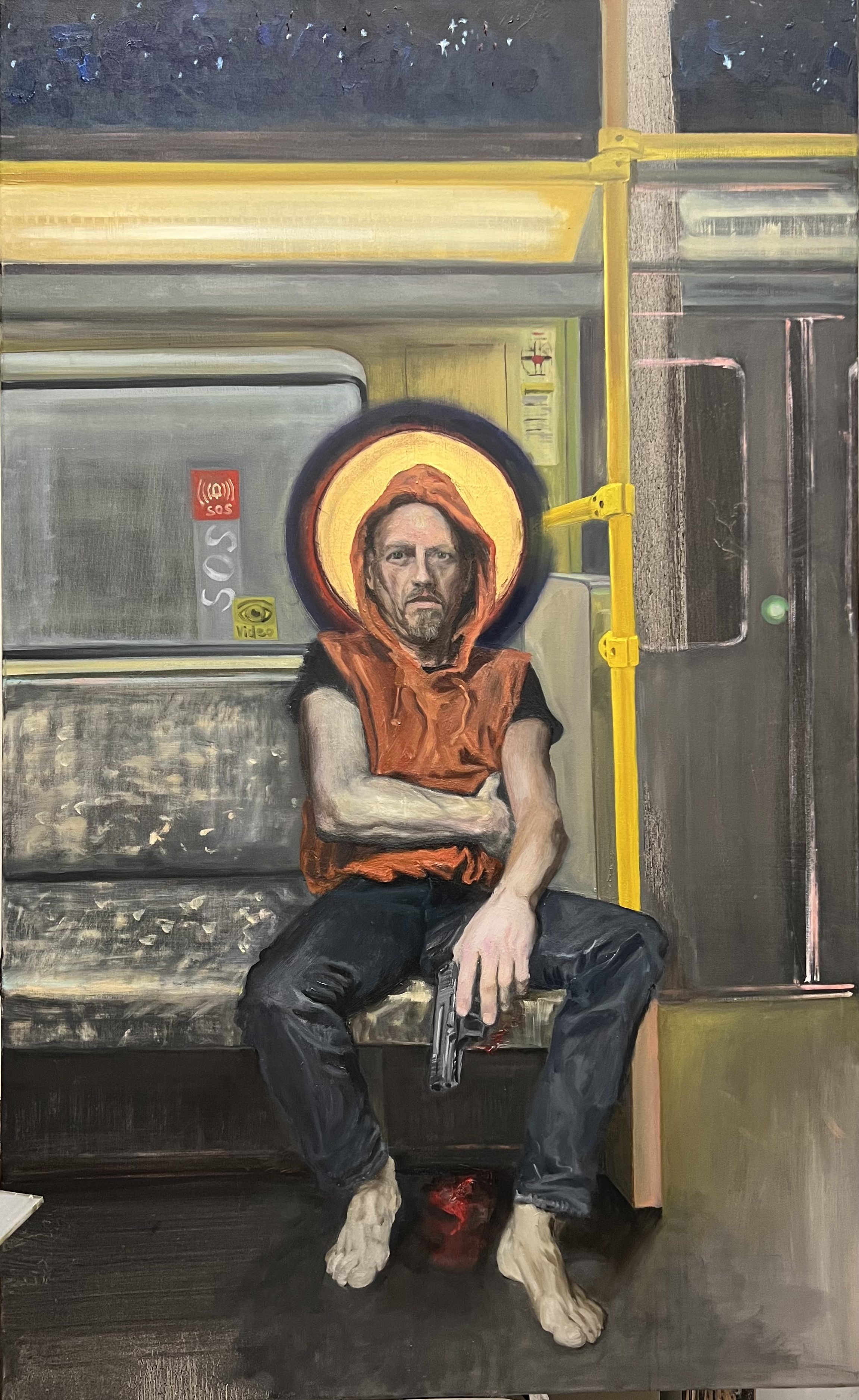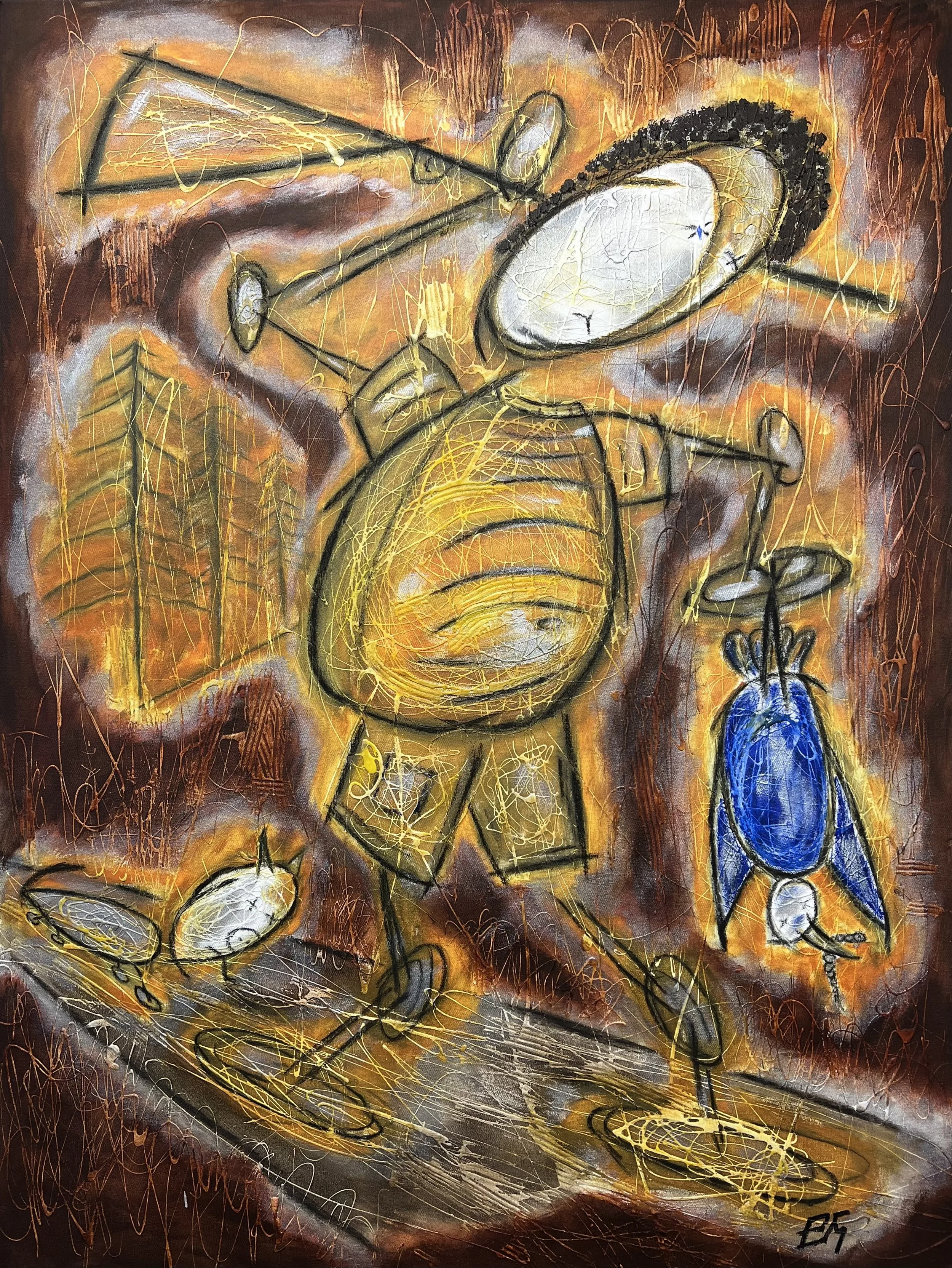Tilmann Krumrey
Navigating the works of Tilmann Krumrey is like embarking on an odyssey through the profoundest strata of human existence, underpinned by a narrative that transcends mere visual delight to engage in a deeper dialogue with the essence of being. Krumrey’s artistic journey is distinct, marked by his lineage steeped in the Bauhaus tradition through his father, Immo Krumrey, and an early exposure to a milieu of significant artistic influences. From the post-expressionist echoes in the studio of Doris von Sengbusch-Eckardt to the avant-garde undercurrents he absorbed from Prof. Albert Fessler, Krumrey’s formative experiences frame a sophisticated tableau of historical and conceptual artistry.
Krumrey’s work reflects a compelling synthesis of this artistic heritage and his own deep-seated inquiries into human conditions. Each sculpture and painting is not merely an aesthetic artifact but an intersection of history, philosophy, and personal narrative, making his creations resonate with an intensity that is both intimate and universal. This intensity is particularly palpable in his sculptures such as "Brothers" and "Silence," where the solid forms of patinated bronze are juxtaposed with the fluid, often tormented expressions of human figures, embodying a tension between the eternal and the ephemeral.
In the lineage of sculptors, Krumrey’s approach could be likened to that of Rodin, yet with a modern twist that incorporates the integration of multimedia and the spatial dynamics of installation art. Like Rodin, Krumrey is fascinated by the expressive potential of the human form, exploring its every nuance from agony to serenity. His sculptures transcend traditional aesthetics to engage with viewers on a level that is at once primordial and profoundly contemporary.
Krumrey's unique application of traditional materials—stone, wood, plaster, wax, bronze, and metal—underscores a narrative that speaks to the innovation of statement and style rather than novelty for its own sake. His use of these materials does not merely serve as a nod to classicism but rather as a means to bridge the historical with the contemporary, providing a tangible weight to the themes of human struggle and resilience that pervade his work.
His exploration of painting manifests a similar depth. Works such as "Das Grüne Land ll" and "The Encounter" reveal his capability to convey complex, layered landscapes that encapsulate not just physical spaces but the vast landscapes of human emotion and consciousness. These paintings, often massive and imposing, do not just depict scenes; they are portals to introspection, inviting the viewer to step into a world where nature and the human psyche are entwined.
Krumrey’s art is emblematic of a 'Gesamtkunstwerk,' a total work of art that seeks to synthesize the sensory experiences of space, sound, and sight. In this regard, his exhibitions are not just displays; they are immersive experiences that alter consciousness, akin to the environmental sculptures of James Turrell, yet imbued with the narrative density of a Wagnerian opera. His installations create a stage upon which the drama of human existence unfolds, engaging all senses and inviting viewers to a participative experience in the artwork.
The philosophical underpinnings of Krumrey’s oeuvre are evident in his systematic approach to the human figure, exploring fundamental states of being through creative permutations of body positions. This methodical exploration is reminiscent of the analytical processes of Bauhaus, where form and function are distilled to their essence and recombined to reveal new meanings. Krumrey extends this approach into the morphological, creating a lexicon of human form that is both a study in anatomy and a discourse on the human condition.
In the contemporary art scene, Krumrey’s work holds a distinctive place, bridging the gap between the representational and the conceptual, the physical and the metaphysical. His sculptures and paintings do not simply occupy space; they create space—a space for contemplation, for emotion, for existential reckoning. This capacity to evoke the spectral range of human experiences places him in the rare echelon of artists whose works are timeless yet immediate, personal yet universal.
Tilmann Krumrey’s art is a testament to the enduring power of traditional materials and techniques in the dialogue of contemporary art. It challenges the viewer to confront fundamental aspects of human nature, offering not only a mirror to our own conditions but also a window into the realms of what it means to be human in a post-modern world. Through his profound engagement with form, material, and space, Krumrey not only continues the legacy of his artistic forebears but also carves a distinct niche for himself in the annals of contemporary art. His works are not just seen; they are experienced, making him one of the most compelling artists of our time.
Krumrey's art extends an invitation to the viewers to explore the inner dimensions of human experience through a lens that is simultaneously archaic and acutely modern. His meticulous attention to the contours of human emotion and his deliberate manipulation of forms imbue his creations with a visceral impact that challenges the boundaries of traditional sculpture and painting.
In his sculptures, the emotional gravitas of each figure is palpable, rendered with a precision that transcends the mere physicality of the materials. For instance, the piece "Impotence" is a profound study of vulnerability and defeat, where the figure's exaggerated, almost contorted posture and expression of despair strikingly contrast with the inherent strength and permanence of bronze. This paradoxical relationship between material and subject matter in Krumrey’s works invites a contemplation of the human condition that is rare in contemporary art, where often the emphasis is placed more on aesthetic innovation rather than emotional depth.
His paintings are not mere representations but are narratives themselves, characterized by their atmospheric depth and a palette that speaks directly to the subconscious. In "Metanoia" and "SchmerzensmannImago pietatis," there is an almost palpable sense of transformation and introspection, conveyed through the dramatic interplay of light and shadow, the ethereal application of gold leaf, and the haunting gaze of the subjects. These elements are not used merely as visual tools but are integral to the storytelling process, enhancing the symbolic and emotional resonance of the works.
Krumrey's philosophical engagement with the themes of existence and transformation is further reflected in his thoughtful integration of spatial and sensory elements into his installations. These installations do more than simply showcase his sculptures and paintings; they create a milieu where the boundaries between the artwork and the viewer dissolve, fostering an environment where art becomes an experiential and transformative encounter. This approach is reminiscent of Joseph Beuys' social sculptures, where the art acts as a catalyst for personal and communal change.
The profound influence of the Bauhaus tradition is evident not only in Krumrey’s aesthetic choices but also in his integrative approach to art as a holistic experience. His background in art history and economics also enriches his practice, allowing him to draw from a diverse array of cultural and theoretical frameworks to inform his art. This interdisciplinary foundation enables Krumrey to construct artworks that are not only visually arresting but also intellectually and emotionally layered, offering multiple entry points for interpretation and engagement.
Krumrey’s place in the contemporary art scene is marked by his ability to synthesize these various elements into a coherent philosophical and aesthetic vision. His works are celebrated not only for their technical mastery and innovative use of traditional materials but also for their capacity to engage with timeless existential themes through a distinctly modern lens. In this sense, Krumrey is not just creating art; he is crafting a language of human experience that is deeply relevant in today’s cultural landscape.
In the panorama of contemporary art, where the transient often overshadows the timeless, Krumrey’s commitment to exploring the enduring facets of human existence through art makes his work not only unique but also essential. His sculptures and paintings are more than mere objects of beauty; they are poignant reflections on life, loss, redemption, and the inexorable march of time. His ability to navigate these themes with both subtlety and power secures his position as a vital voice in contemporary art, one that speaks with the weight of tradition behind him and a keen eye towards the future.
Tilmann Krumrey’s artistic oeuvre is a profound exploration into the very core of human existence, executed with a mastery that bridges historical reverence and contemporary insight. His works, deeply rooted in the Bauhaus tradition yet vibrant with an innovative spirit, challenge and expand the boundaries of traditional sculpture and painting. By invoking the timeless through the lens of modernity, Krumrey does not merely create art; he creates a legacy that dialogues with the soul of the viewer, urging a reexamination of the human condition.
In a world where art often gravitates towards the ephemeral, Krumrey’s creations stand as monumental tributes to the enduring human spirit. They are not just sculptures and paintings but are meditations on the complexities of human emotions and existential dilemmas. His ability to distill profound truths into tangible forms places him among the luminaries of contemporary art, where his voice resonates with both the echoes of the past and the questions of the future.
As we contemplate Krumrey's works, we are not merely observers but participants in a narrative woven with the threads of human experience. His art compels us to confront our vulnerabilities, celebrate our strengths, and ponder our place within the broader tapestry of existence. Through his visionary use of form, material, and space, Krumrey invites us to transcend the mundane, offering a sanctuary where we can confront the universal truths of our lives.
Krumrey’s contributions to the art world are indelible, marked by a profound ability to communicate the incommunicable. His works serve as both mirrors and windows—mirrors that reflect our innermost selves, and windows that open onto vistas of new understanding and insight. In this, his art is not only seen but felt, a rare quality that elevates his pieces from mere objects to be viewed to experiences to be lived.
Tilmann Krumrey is not just an artist but a philosopher of the visual, whose works will undoubtedly continue to inspire, challenge, and evoke deep emotional responses for generations.
By Marta Puig
Editor Contemporary Art Curator Magazine
Impotence, 2008, patinated bronze, 197 x 33 x 48 cm, ca. 147 kg
Silence, 2010,patinated bronze, 197 x 36 x 45 cm, ca. 155 kg
Brothers, 2010, patinated bronze, 315 x 90 x 135 cm, ca. 450 k
Bunny Bishop, 2013, graphite, pigment, pencil on paper. Mounted on MDF, 149,5 x 92,5 c
Wanderer im grünen Land, 2022, oil on canvas. 73 x 6
Schmerzensmann/Imago pietatis, 2023-24, oil on canvas, gold leaf, 130 x 80 cm
Das Grüne Land ll, 2020-24, oil on canvas. 130 x 210 c
Blaues Blut, 2023, oil on plywood. 80 x 60 c
Metanoia, 2022, oil on canvas. 130 x 80 c
The Encounter, 2024, oil on plywood. 60 x 80 cm













